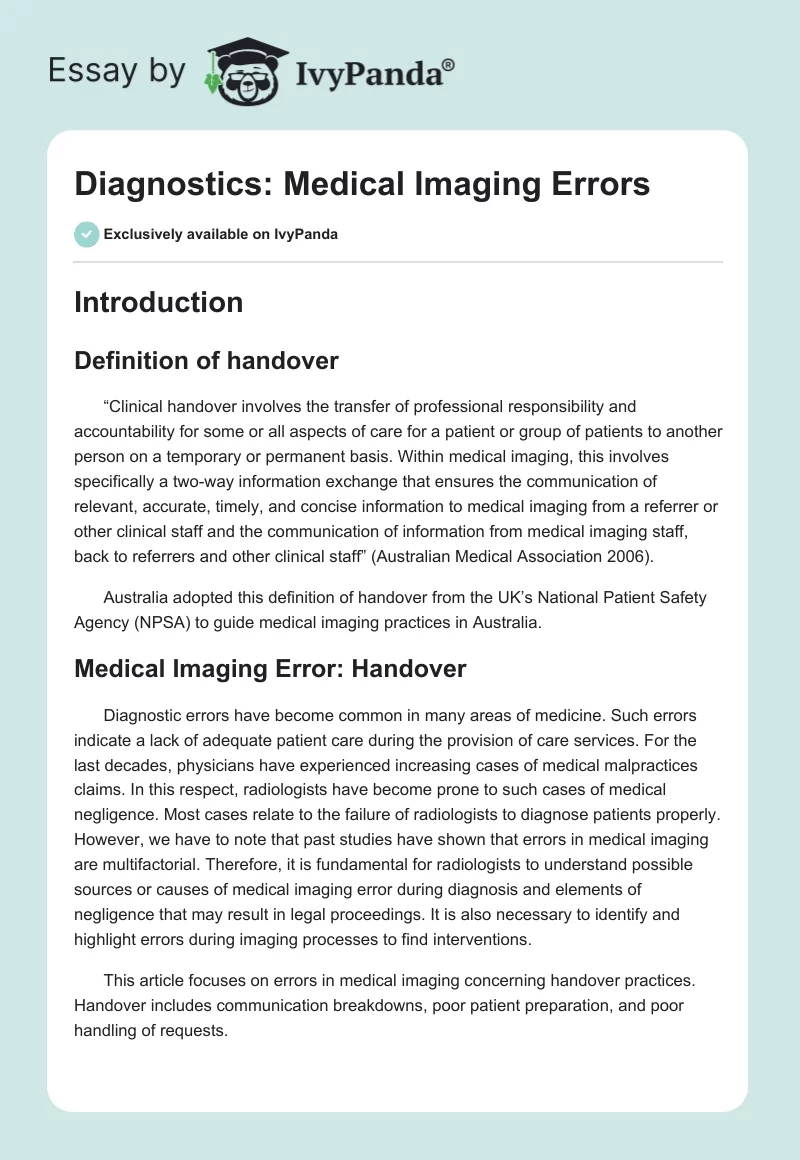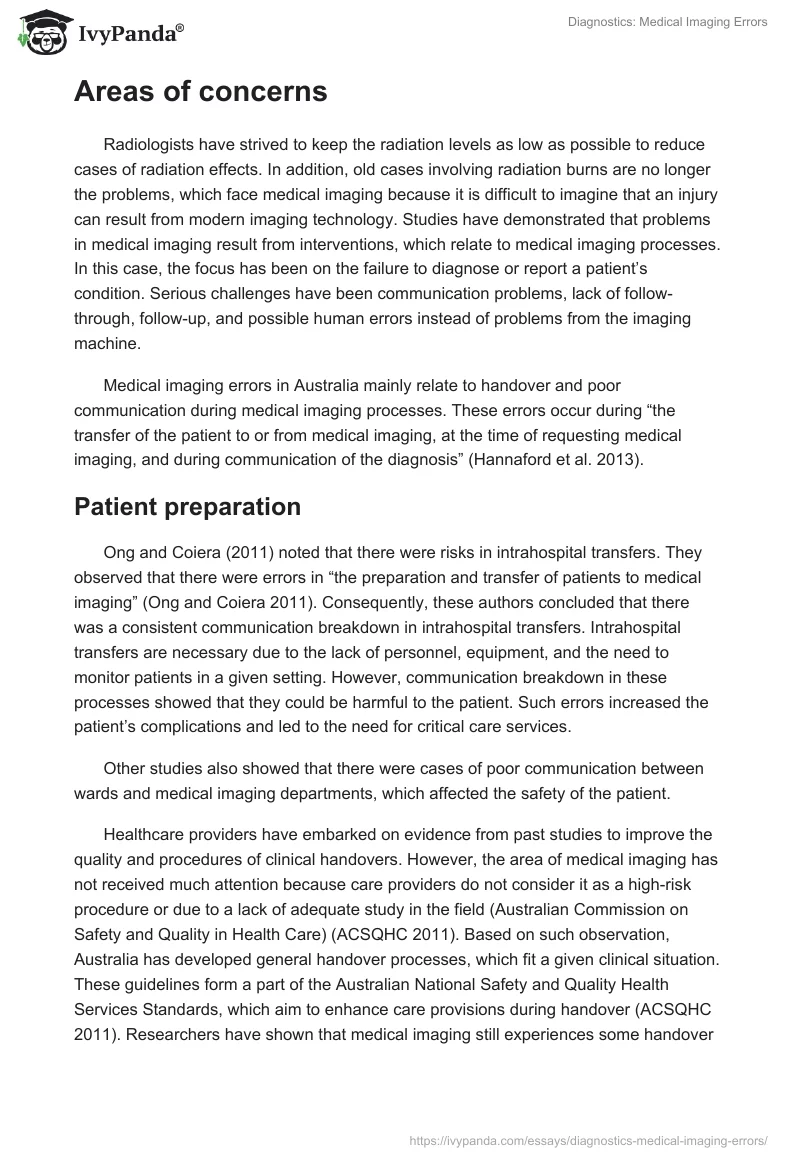Introduction
Definition of handover
“Clinical handover involves the transfer of professional responsibility and accountability for some or all aspects of care for a patient or group of patients to another person on a temporary or permanent basis. Within medical imaging, this involves specifically a two-way information exchange that ensures the communication of relevant, accurate, timely, and concise information to medical imaging from a referrer or other clinical staff and the communication of information from medical imaging staff, back to referrers and other clinical staff” (Australian Medical Association 2006).
Australia adopted this definition of handover from the UK’s National Patient Safety Agency (NPSA) to guide medical imaging practices in Australia.
Medical Imaging Error: Handover
Diagnostic errors have become common in many areas of medicine. Such errors indicate a lack of adequate patient care during the provision of care services. For the last decades, physicians have experienced increasing cases of medical malpractices claims. In this respect, radiologists have become prone to such cases of medical negligence. Most cases relate to the failure of radiologists to diagnose patients properly. However, we have to note that past studies have shown that errors in medical imaging are multifactorial. Therefore, it is fundamental for radiologists to understand possible sources or causes of medical imaging error during diagnosis and elements of negligence that may result in legal proceedings. It is also necessary to identify and highlight errors during imaging processes to find interventions.
This article focuses on errors in medical imaging concerning handover practices. Handover includes communication breakdowns, poor patient preparation, and poor handling of requests.
Areas of concerns
Radiologists have strived to keep the radiation levels as low as possible to reduce cases of radiation effects. In addition, old cases involving radiation burns are no longer the problems, which face medical imaging because it is difficult to imagine that an injury can result from modern imaging technology. Studies have demonstrated that problems in medical imaging result from interventions, which relate to medical imaging processes. In this case, the focus has been on the failure to diagnose or report a patient’s condition. Serious challenges have been communication problems, lack of follow-through, follow-up, and possible human errors instead of problems from the imaging machine.
Medical imaging errors in Australia mainly relate to handover and poor communication during medical imaging processes. These errors occur during “the transfer of the patient to or from medical imaging, at the time of requesting medical imaging, and during communication of the diagnosis” (Hannaford et al. 2013).
Patient preparation
Ong and Coiera (2011) noted that there were risks in intrahospital transfers. They observed that there were errors in “the preparation and transfer of patients to medical imaging” (Ong and Coiera 2011). Consequently, these authors concluded that there was a consistent communication breakdown in intrahospital transfers. Intrahospital transfers are necessary due to the lack of personnel, equipment, and the need to monitor patients in a given setting. However, communication breakdown in these processes showed that they could be harmful to the patient. Such errors increased the patient’s complications and led to the need for critical care services.
Other studies also showed that there were cases of poor communication between wards and medical imaging departments, which affected the safety of the patient.
Healthcare providers have embarked on evidence from past studies to improve the quality and procedures of clinical handovers. However, the area of medical imaging has not received much attention because care providers do not consider it as a high-risk procedure or due to a lack of adequate study in the field (Australian Commission on Safety and Quality in Health Care) (ACSQHC 2011). Based on such observation, Australia has developed general handover processes, which fit a given clinical situation. These guidelines form a part of the Australian National Safety and Quality Health Services Standards, which aim to enhance care provisions during handover (ACSQHC 2011). Researchers have shown that medical imaging still experiences some handover challenges. Therefore, there is a need for stakeholders to develop specific handover procedures for medical imaging problems.
Patients also experience unsafe transfer to the medical imaging department. In some cases, critically ill patients went to the medical imaging department without an escort with nurses or suitable equipment. In this regard, policymakers should develop a clinical handover procedure, which includes the safe transfer of patients to medical imaging to address risks associated with the unsafe transfer. The transfer procedure should account for all rights of the patient during transfers, which include:
- Timely transfer
- Right equipment and documentation
- Supervision
- Resources at the receiving end for adequate care services
Request
There are also errors in requests, which relate to the content of the request form and lack of effective communication between the patient ward and the medical imaging department. Improvements in technology and subsequent adoption of IT in the provision of healthcare services should address such problems. Information technology (IT) can improve the efficiency and safety of information delivered. It can increase the timely transfer of information among people. However, the use of technology in healthcare provision faces challenges because of poor planning, testing, and implementation. These challenges also create new sorts of problems for users and patients.
Some studies have shown that overreliance on online systems to transfer medical imaging data may lead to errors. Online referral and electronic data require thorough reviews to ensure that captured data are accurate. Some scholars have suggested that appropriate clinical decision support can reduce cases of wrong requests (Roshanov et al. 2011). The system can introduce checklists and compulsory fields, which physicians must complete before generating a request. Such automated systems should enhance the work of physicians with aim of reducing human errors, which occur in the process of requesting medical imaging.
Communication challenges
Many researchers have studied the effects of miscommunication in healthcare setups and outlined challenges with communication in diagnosis (Khorasani 2009; Berlin 2006). In fact, in some studies, Berlin suggests that radiologists should communicate results directly to patients. There are cases of delayed communication diagnosis and communication of wrong results. Therefore, healthcare services must adopt systems, which reduce communication of wrong results and failure to communicate. In this process, care providers must also safeguard patients’ information while those who handle patients’ data must know that they have obligations to confirm all requests of the patient in the final report from medical imaging.
Callen and colleagues studied the problems of missed test results and noted that there were considerable cases with negative impacts on the patient (Callen et al. 2011). In some cases, studies have established that online communication also had challenges of follow through and follow up. On this note, the World Alliance for Patient Safety has shown that poor “test follow-up was one major process that contributed to unsafe patient care” (Callen et al. 2011). Poor follow-up increased cases of missed or delayed diagnoses and posed risks to patients. Such cases resulted in suboptimal care and potential medico-legal challenges.
Many nurses have expressed their concerns that test management practices are not effective because of huge differences in practices (Poon et al. 2004). Others have claimed that IT can reduce such challenges in healthcare provisions. However, research in the effectiveness of IT in healthcare and result management remains limited (Callen et al. 2011).
It is crucial to note that managing follow-up cases of medical imaging results may be a difficult process. The process involves “information exchange among patients, doctors, nurses, and laboratories using a combination of information systems, including paper-based, telephone and electronic systems, which involve a variety of policies and procedures” (Callen et al. 2011). This process also has the potential to create risk factors in medical imaging.
Effective communication between the medical imaging department and the referrer can reduce cases of miscommunication and increase the safety of patients. At the same time, physicians should alert the medical imaging department during the interpretation of results to avoid wrong interpretation, detect errors, and correct discrepancies before any subsequent procedure on the patient take place. Physicians should also acknowledge test results and ensure that such results correspond to the tests requested.
Communication errors have also increased the number of medico-legal challenges against medical imaging practitioners. Medical imaging practitioners must note that they have effective roles to play in reducing cases of failure to communicate medical imaging results. Practitioners should also document their communication and test results to protect themselves in cases of adverse clinical outcomes (Pinto and Brunese 2010).
Conclusion
All clinicians want to provide the best care services to patients. However, errors in practices and procedures in handover processes of patients and patients’ data are common in medical imaging because many practitioners consider medical imaging as a department with limited risks. Physicians must adequately prepare patients during transfers to and from the medical imaging department. This process must involve effective reviews and follow-through on patients’ test results to avoid errors in medical imaging and issues of malpractices, which can lead to medico-legal challenges.
Handover issues are also prevalent in IT systems. Thus, IT has not been effective in solving handover challenges. New types of errors have emerged in medical imaging from the IT system because of failures to follow through with test results. In some cases, physicians fail to check the accuracy of data entered into the system.
The main aims of studying and understanding medical imaging errors are to identify and reduce such cases. Reducing errors in medical imaging enhances patient care, reduces cases of critical care, costs, and improves the image of the healthcare facility.
To reduce cases of errors in medical imaging procedures, healthcare providers must facilitate effective communications among themselves. In this regard, healthcare providers should understand the importance of timely, accurate, and effective communication during handover procedures of medical imaging results. Many physicians have shown that the healthcare system has a complex system of managing test results. The situation has become a risk in handling patients’ results. Therefore, care providers must improve efficiency and follow-through test results to ensure that they are accurate and reach the intended referrer.
References
Australian Commission on Safety and Quality in Health Care (ACSQHC). National Safety and Quality Health Service Standards. Sydney, Australia: ACSQHC, 2011.
Australian Medical Association. Safe handover safe patients: Guidance on clinical handover for clinicians and managers. Kingston, Australia: Australian Medical Association Limited, 2006.
Berlin, Leonard. “Communicating radiology results.” Lancet 367, no. 9508 (2006): 373- 5.
Callen, Joanne, Andrew Georgiou, Julie Li, and Johanna Westbrook. “The safety implications of missed test results for hospitalized patients: a systematic review.” BMJ Qual Saf Health Care 20, no. 2 (2011): 194–199.
Hannaford, Natalie et al. “Learning from incident reports in the Australian medical imaging setting: handover and communication errors.” British Journal of Radiology 86, no. 1022 (2013): 1-11.
Khorasani, Ramin. “Optimizing communication of critical test results.” J Am Coll Radiology 6, no. 10 (2009): 721-3.
Ong, Mei-Sing and Coiera Enrico. “A systematic review of failures in handoff communication during intrahospital transfers.” Jt Comm J Qual Patient Safety 37, no. 6 (2011): 274-84.
Pinto, Antonio and Luca Brunese. “Spectrum of diagnostic errors in radiology.” World J Radiology 2, no. 10 (2010): 377–383.
Poon, G et al. “I wish I had seen this test result earlier!’: Dissatisfaction with test result management systems in primary care.” Arch Intern Med. 164, no. 20 (2004): 2223-8.
Roshanov, P et al. “Can computerized clinical decision support systems improve practitioners’ diagnostic test ordering behavior? A decision-maker-researcher partnership systematic review.” Implement Science 3, no. 6 (2011): 88.


